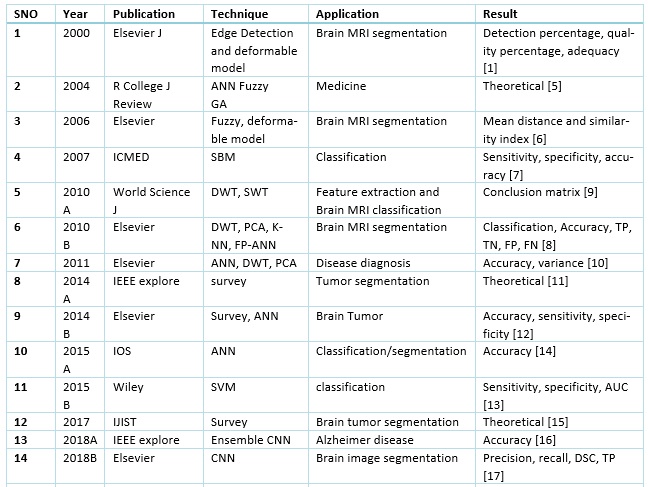A Review on the use of Artificial Intelligence Techniques in Brain MRI Analysis

DOI:
https://doi.org/10.54060/JIEEE/002.02.010Keywords:
Brain MRI, Image segmentation, Artificial Intelligence, ClassificationAbstract
Over the past 20 years, the global research going on in Artificial Intelligence in applica-tions in medication is a venue internationally, for medical trade and creating an ener-getic research community. The Artificial Intelligence in Medicine magazine has posted a massive amount. This paper gives an overview of the history of AI applications in brain MRI analysis to research its effect at the wider studies discipline and perceive de-manding situations for its destiny. Analysis of numerous articles to create a taxono-my of research subject matters and results was done. The article is classed which might be posted between 2000 and 2018 with this taxonomy. Analyzed articles have excessive citations. Efforts are useful in figuring out popular studies works in AI primarily based on mind MRI analysis throughout specific issues. The biomedical prognosis was ruled by way of knowledge engineering research in its first decade, whilst gadget mastering, and records mining prevailed thereafter. Together these two topics have contributed a lot to the latest medical domain.
Downloads
References
L. Germond, M. Dojat, C. Taylor, et al., “A cooperative framework for segmentation of MRI brain scans,” Artif. Intell. Med., vol. 20, no. 1, pp. 77–93, 2000.
T. Kapur, W. E. Grimson, W. M. Wells et al., “Segmentation of brain tissue from magnetic resonance images,” Med. Image Anal., vol. 1, no. 2, pp. 109–127, 1996.
P. C. Teo, G. Sapiro, and B. A. Wandell, “Creating connected representations of cortical gray matter for functional MRI visualization,” IEEE Trans. Med. Imaging, vol. 16, no. 6, pp. 852–863, 1997.
S. Warfield, J.Dengler, J. Zares, et al.,” Automatic identification of gray matter structures from MRI to improve the segmentation of white matter lesions”. J Image Guid Surg, vol. 1, pp. 326–338 ,1995.
A. N. Ramesh, C. Kambhampati, J. R. T. Monson, et al., “Artificial intelligence in medicine,” Ann. R. Coll. Surg. Engl., vol. 86, no. 5, pp. 334–338, 2004.
O. Colliot, O. Camara, and I. Bloch, “Integration of fuzzy spatial relations in deformable models—Application to brain MRI segmentation,” Pattern Recognit., vol. 39, no. 8, pp. 1401–1414, 2006.
H. Selvaraj, S. T. Selvi, D. Selvathi, et al., “Brain MRI slices classification using least squares support vector machine,” Int. J. Intell. Comput. Med. Sci. Image Process., vol. 1, no. 1, pp. 21–33, 2007.
E.-S. A. El-Dahshan, T. Hosny, et al., “Hybrid intelligent techniques for MRI brain images classification,” Digit. Signal Process., vol. 20, no. 2, pp. 433–441, 2010.
Y. Zhang, S. Wang, Y. Huo, L. Wu, and A. Liu, “Feature extraction of brain MRI by stationary wavelet transform and its applications,” J. Biol. Syst., vol. 18, no. spec01, pp. 115–132, 2010.
Y. Zhang, Z. Dong, L. Wu, and S. Wang, “A hybrid method for MRI brain image classification,” Expert Syst. Appl., vol. 38, no. 8, pp. 10049–10053, 2011.
J. Liu, M. Li, J. Wang, et al., "A survey of MRI-based brain tumor segmentation methods," in Tsinghua Science and Technology, vol. 19, no. 6, pp. 578-595, Dec. 2014.
E.-S. A. El-Dahshan, H. M. Mohsen, K. Revett, et al., “Computer-aided diagnosis of human brain tumor through MRI: A survey and a new algorithm,” Expert Syst. Appl., vol. 41, no. 11, pp. 5526–5545, 2014.
A. Larroza, D. Moratal, A.P. Sanchez MS, et al., “Support vector machine classification of brain metastasis and radiation necrosis based on texture analysis in MRI: Metastasis/Radionecrosis Discrimination,” J. Magn. Reson. Imaging, vol. 42, no. 5, pp. 1362–1368, 2015.
M. Nazir, W. Fazil, A. Khan, et. al., " A simple and intelligent approach for brain MRI classification", Journal of Intelligent & Fuzzy Systems, vol. 28, no. 3, Pages 1127-1135, 2015.
M. Angulakshmi, and G. G. L. Priya, “Automated brain tumour segmentation techniques- A review,” Int. J. Imaging Syst. Technol., vol. 27, no. 1, pp. 66–77, 2017.
J. Islam and Y. Zhang, “Brain MRI analysis for Alzheimer’s disease diagnosis using an ensemble system of deep convolutional neural networks,” Brain Inform., vol. 5, no. 2, 2018.
M. F. Rachmadi, M.D.C. V. Hernández, M. L. F. Agan, et al., “Segmentation of white matter hyperintensities using convolutional neural networks with global spatial information in routine clinical brain MRI with none or mild vascular pathology,” Comput. Med. Imaging Graph., vol. 66, pp. 28–43, 2018.
J. Bernal, K. Khushibar, D.S. Asfaw, et al., “Deep convolutional neural networks for brain image analysis on magnetic resonance imaging: a review,” Artif. Intell. Med., vol. 95, pp. 64–81, 2019.
O. Russakovsky, J. Deng, H. Su, et al., “ImageNet large scale visual recognition challenge,” Int. J. Comput. Vis., vol. 115, no. 3, pp. 211–252, 2015.
T.-Y. Lin, M. Marie, S. Belongie, et al., “Microsoft COCO: Common objects in context,” in Computer Vision – ECCV, Cham: Springer International Publishing, vol.8693, pp. 740–755, 2014.
M. Everingham, S. M. A. Eslami, L. Van Gool, C. K. I. Williams, J. Winn, and A. Zisserman, “The pascal visual object classes challenge: A retrospective,” Int. J. Comput. Vis., vol. 111, no. 1, pp. 98–136, 2015.
A. Krizhevsky, I. Sutskever, G.E. Hinton, et. al.,” Imagenet classification with deep convolutional neural networks, in: Advances in neural information processing systems”, pp. 1097–1105, 2012.
K. He, X. Zhang, S. Ren, et. al., “Deep residual learning for image recognition, in: Proceedings of the IEEE Conference on Computer Vision and Pattern Recognition” pp. 770–778, 2016.
C. Szegedy, S. Ioffe, V. Vanhoucke, et al. "Inception-v4, inception-resnet and the impact of residual connections on learning." Thirty-first AAAI conference on artificial intelligence, pp. 4278–4284, 2017.
H. Noh, S. Hong, B. Han,” Learning deconvolution network for semantic segmentation, in: Proceedings of the IEEE International Conference on Computer Vision,” pp. 1520–1528, 2015.
L.-C. Chen, G. Papandreou, I. Kokkinos, et al., “Semantic image segmentation with deep convolutional nets and fully connected CRFs,” 2014.
A. Wadhwa, A. Bhardwaj, and V. Singh Verma, “A review on brain tumor segmentation of MRI images,” Magn. Reson. Imaging, vol. 61, pp. 247–259, 2019.
A. B. Rabeh, F. Benzarti, and H. Amiri, “Segmentation of brain MRI using active contour model,” Int. J. Imaging Syst. Technol., vol. 27, no. 1, pp. 3–11, 2017.
F. Derraz, M. Beladgham and M. Khelif, "Application of active contour models in medical image segmentation," International Conference on Information Technology: Coding and Computing, Proceedings. ITCC vol. 2, pp. 675–681, 2004.
R. Meier, U., Knecht, T. Loosli, et al. Clinical Evaluation of a Fully-automatic Segmentation Method for Longitudinal Brain Tumor Volumetry. Sci. Rep., vol. 6, no. 1, pp. 233-376, 2016.
N. Gordillo, E. Montseny, and P. Sobrevilla, “State of the art survey on MRI brain tumor segmentation,” Magn. Reson. Imaging, vol. 31, no. 8, pp. 1426–1438, 2013.
T. M. Noguerol, F. P. Godino, M. T. M. Valdivia, et al., “Strengths, weaknesses, opportunities, and threats analysis of artificial intelligence and machine learning applications in radiology,” J. Am. Coll. Radiol., vol. 16, no. 9, pp,1239–1247, 2019.
S. Lu, Z. Lu, and Y.-D. Zhang, “Pathological brain detection based on AlexNet and transfer learning,” J. Comput. Sci., vol. 30, pp. 41–47, 2019.
M. Owais, M. Arsalan, J. Choi, et al., “Effective diagnosis and treatment through content-based medical image retrieval (CBMIR) by using artificial intelligence,” J. Clin. Med., vol. 8, no. 4, 2019.
S. Huang, J. Yang, S. Fong, et al., “Mining prognosis index of brain metastases using artificial intelligence,” Cancers (Basel), vol. 11, no. 8, 2019.
R. L. Siegel, K. D. Miller, and A. Jemal, “Cancer statistics,” CA Cancer J. Clin., vol. 69, no. 1, pp. 7–34, 2019.
M. W. Kattan, K.R. Hess, B. Mahul, et al., “American Joint Committee on Cancer acceptance criteria for inclusion of risk models for individualized prognosis in the practice of precision medicine,” CA Cancer J. Clin., vol. 66, no. 5, pp. 370–374, 2016.
M. Alexander, R. Wolfe, D. Ball, et al., “Lung cancer prognostic index: a risk score to predict overall survival after the diagnosis of non-small-cell lung cancer,” Br. J. Cancer, vol. 117, no. 5, pp. 744–751, 2017.
N. Fujima, Y. Shimizu, D. Yoshida, et al., “Machine-learning-based prediction of treatment outcomes using MR imaging-derived quantitative tumor information in patients with sinonasal squamous cell carcinomas: A preliminary study,” Cancers (Basel), vol. 11, no. 6, 2019.
J. Kleesiek, M. D. Morhuis, J.N. Bs, et al., “Can virtual contrast enhancement in brain MRI replace gadolinium? A feasibility study: A feasibility study,” Invest. Radiol., vol. 54, no. 10, pp. 653–660, 2019.
M. Mostapha and M. Styner, “Role of deep learning in infant brain MRI analysis,” Magn. Reson. Imaging, vol. 64, pp. 171–189, 2019.
A. M. Rauschecker, J.F. Rudie, L. Xie, et al., “Artificial intelligence system approaching neuroradiologist-level differential diagnosis accuracy at brain MRI,” Radiology, vol. 295, no. 3, pp. 626–637, 2020.
M. P. McBee, O. A, A.MD, A.T. Colucci, et al., “Deep Learning in radiology,” Acad. Radiol., vol. 25, no. 11, pp. 1472–1480, 2018.
D. Shen, G. Wu, and H.-I. Suk, “Deep learning in medical image analysis,” Annu. Rev. Biomed. Eng., vol. 19, no. 1, pp. 221–248, 2017.
M. W. Nadeem, M.A.A. Ghamdi, M. Hussain, et al., “Brain tumor analysis empowered with deep learning: A review, taxonomy, and future challenges,” Brain Sci., vol. 10, no. 2, 2020.
X. Zhao, Y. Wu, G. Song, et al., “A deep learning model integrating FCNNs and CRFs for brain tumor segmentation,” Med. Image Anal., vol. 43, pp. 98–111, 2018.
N. Singh, & A. Jindal, “Ultra sonogram images for thyroid segmentation and texture classification in diagnosis of malignant (cancerous) or benign (non-cancerous) nodules.”, Int. J. Eng. Innov. Technol, vol. 1, pp.202–206, 2012.
M.C. J Christ, S. Sivagowri, P.G. Babu, et. al.,” Segmentation of brain tumors using Meta heuristic algorithms”, Open J. Commun. Soft, vol. 1, no.1, pp. 1–10, 2014.
L. Lazli, M. Boukadoum, and O. A. Mohamed, “A survey on computer-aided diagnosis of brain disorders through MRI based on machine learning and data mining methodologies with an emphasis on Alzheimer disease diagnosis and the contribution of the multimodal fusion,” Appl. Sci. (Basel), vol. 10, no. 5, 2020.
A. Besga, M. Termenon, M. Graña, et al., “Discovering Alzheimer’s disease and bipolar disorder white matter effects building computer aided diagnostic systems on brain diffusion tensor imaging features,” Neurosci. Lett., vol. 520, no. 1, pp. 71–76, 2012.
P. Singhal, P. Singh, and A. Vidyarthi,” Interpretation and localization of Thorax diseases using DCNN in Chest X-Ray,”Journal of Informatics Electrical and Electronics Engineering, vol.1, no.1, pp. 1-7, April 2020.
A. Singh and P. Singh, “Object Detection,” Journal of Management and Service Science, vol.1, no.2, pp. 1-20, 2021.
A. Singh, P. Singh,” Image Classification: A Survey,” Journal of Informatics Electrical and Electronics Engineering, vol.1, no.2, pp.1-9, 2020.



























